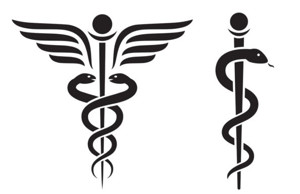Caduceus
How did this symbol come to be associated with medicine?

The Caduceus (left), and the Rod Of Asclepius (right)
(Credit: National Mussum of Civil War Medicine)
No one quite knows, it seems.
Many historians state that the “correct” ancient symbol for medicine is the Rod of Asclepius, which is a single serpent winding around a staff. Asclepius was a diety associated with healing. Myth states that he used snakes in his healing rituals.
The caduceus is a staff with wings, and two serpents intertwined. This is meant to symbolize the god Hermes, and his associated with trade and business.
Other than obvious similarity of the two symbols, it’s not clear how the caduceus came to be associated with medicine. Many assume it was simply confusion, typified by a decision by the U.S. Army in the 1800s to use it as an insignia for medical staff. The usage by the U.S. military continues to this day.
The National Museum of Civil War Medicine writes:
After the Civil War, the U.S. Public Health Service adopted the Caduceus as their symbol in 1871. By 1881, the Caduceus was being used in a limited capacity by the U.S. Army Hospital Corps. It was not until 1902 that the Caduceus was formally adopted as the insignia of both enlisted men and officers of the U.S. Medical Corps. It is thought the Caduceus was meant to indicate the role of the corps as non-combatants rather than to represent the medical role, but no explanation for this choice was ever given.
Wikipedia has an entire page devoted to the question of how the caduceus ended up symbolizing medicine.
Why I Looked It Up
I was a hospital corpsman in the U.S. Navy. The caduceus was the insignia for my role – it was the patch we wore on our uniforms.
I had always wondered where the association came from.